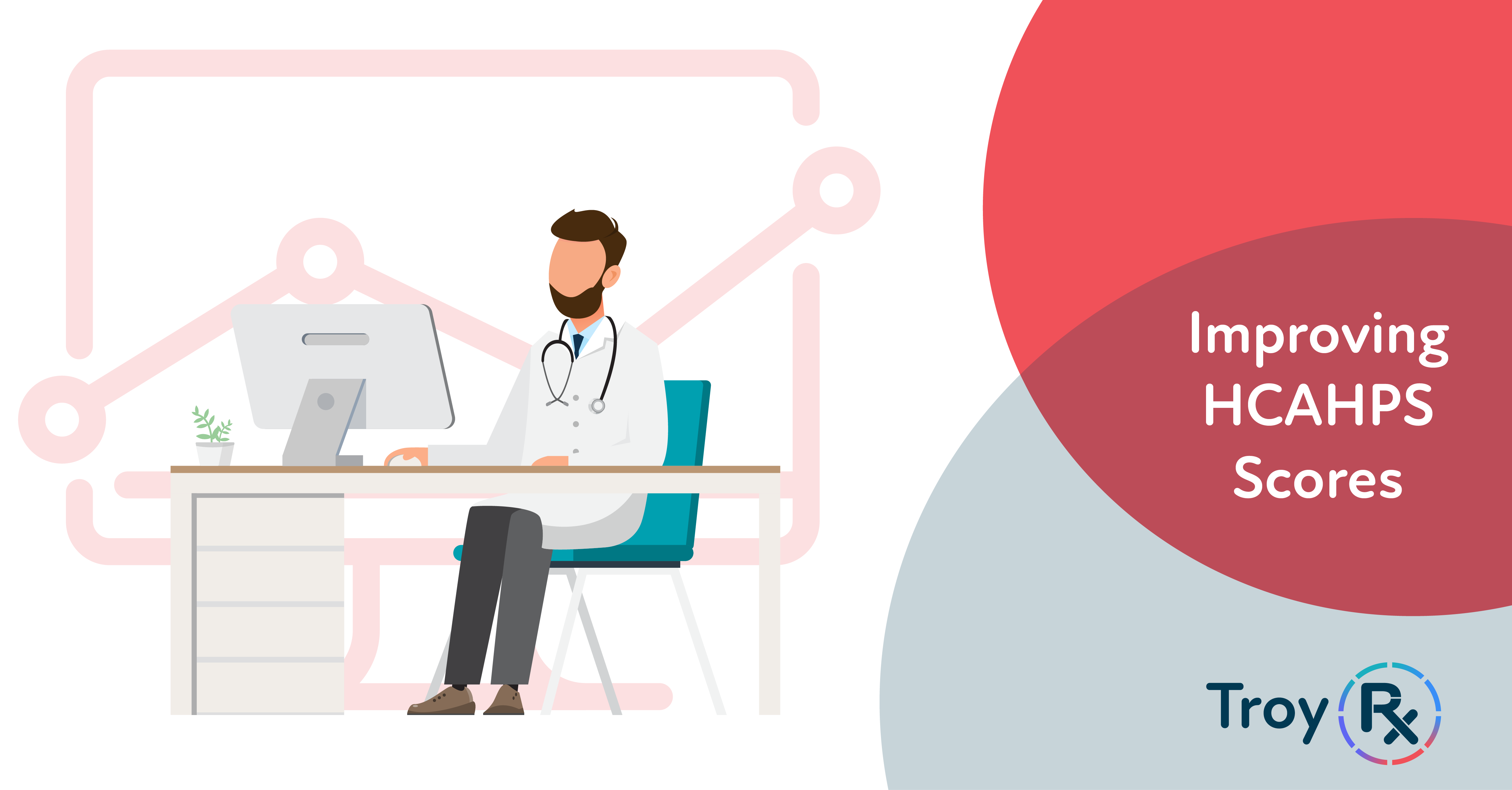اصطياد وحيد القرن HCAHPS وحيد القرن

إن الدرجة المثالية في HCAHPS هي العلامة الوحيدة في مجال الرعاية الصحية. يجب أن يسير كل شيء على أكمل وجه للحصول على تقييم خمس نجوم في الاستطلاع. يجب أن يحب المريض مقدم الرعاية الصحية والممرضين الذين يقدمون له العلاج. يجب أن يقبل المريض خطة العلاج والنصائح التي يقدمها أخصائيو الرعاية الصحية هؤلاء. يجب أن يلتزم المريض بإجراء تغييرات في نمط حياته لتحسين صحته. قد يبدو العبء الذي يقع على عاتق مقدم الرعاية الصحية في الاعتماد على المريض للمشاركة بفاعلية في برنامج الرعاية الخاص به أمرًا مرهقًا وغير قابل للتحقيق.

ما هي درجات HCAHPS؟
في عام 2002، أنشأت مراكز الرعاية الطبية والخدمات الطبية (CMS) استبيان تقييم مستهلكي المستشفيات لمقدمي الرعاية الصحية وأنظمتها (HCAHPS) بعد طلب من وكالة أبحاث الرعاية الصحية والجودة (AHRQ) لتطوير طريقة لقياس تصورات المرضى عن الرعاية التي يتلقونها. إن مشاركة نتائج استبيان HCAHPS علنًا قد زودت مستهلكي الرعاية الصحية بالمعلومات اللازمة لاختيار المستشفى المناسب لهم. المستشفيات التي يتم سداد تكاليفها بموجب نظام الدفع الاستباقي للمرضى الداخليين (IPPS) هي فقط المستشفيات التي يتم سداد تكاليفها بموجب نظام الدفع الاستباقي للمرضى الداخليين (IPPS) هي التي يُطلب منها الإبلاغ عن بيانات الجودة من HCAHPS إلى CMS، ولكن يمكن للمستشفيات الأخرى غير الخاضعة لنظام الدفع الاستباقي للمرضى الداخليين المشاركة طوعًا.
تتألف النتيجة من إجابات على 29 سؤالاً استقصائياً حول إقامة المريض الأخيرة في المستشفى. تتعمق الأسئلة في آراء المريض حول تواصله مع الأطباء والممرضات والمعلومات حول الأدوية والنظافة والهدوء وعملية الخروج من المستشفى واحتمالية توصية المريض بالمستشفى للآخرين. تطلب CMS من المستشفيات المشاركة تلقي 300 استبيان مكتمل على الأقل كل عام.
يمكن أن تؤثر نتائج HCAHPS على الأداء المالي للمستشفى بطريقتين. الطريقة الأولى من خلال السداد من خلال نظام إدارة خدمات الرعاية الصحية الشاملة، حيث تتلقى المستشفيات مدفوعات كاملة مقابل الخدمات إذا كان المريض راضيًا. أما الطريقة الثانية فهي من خلال سمعة العلامة التجارية بين المرضى نظرًا لتزايد النزعة الاستهلاكية في قطاع الرعاية الصحية. مع تزايد عدد المرضى الذين يبحثون عن درجات عالية في تقييم HCAHPS قبل اختيار المنشأة، يجب أن تتنافس المستشفيات على حصتها في السوق لتبقى واقفة على قدميها.
تعزيز HCAHPS بالتكنولوجيا
على الرغم من أنه قد يكون من السهل على قادة الرعاية الصحية الاستسلام والاستسلام، إلا أن التكنولوجيا التي تركز على المريض تضع هدف HCAHPS الوهمي في الأفق. إن تطبيق الأدوات والتكتيكات الصحيحة هو المفتاح. يمكن أن يكون للإجراءات الصغيرة مردود هائل، حيث تركز شركات تكنولوجيا الرعاية الصحية برامجها على طرق التأثير الإيجابي على نتائج HCAHPS.
استفاد فريق TroyRx من علاقاتنا وخبرتنا للتوصل إلى أهم أربع استراتيجيات يمكن لقادة الرعاية الصحية استخدامها للقبض على وحيد القرن في HCAHPS.
- التواصل دائمًا. يجب أن تطبق المستشفيات طرق تواصل متعددة للتفاعل مع المرضى، بما في ذلك المواد المطبوعة والرقمية لاستكمال ما يتم مناقشته. ترغب العديد من أسئلة استبيان HCAPHS في معرفة عدد المرات التي أخبرهم فيها الممرضون ومقدمو الخدمات الصحية عن سبب العلاج والدواء، وما إذا كان موظفو المستشفى قد وصفوا الآثار الجانبية. يمكن للمستشفيات استخدام التكنولوجيا للارتقاء بالمتابعة إلى المستوى التالي من خلال رسائل البريد الإلكتروني والرسائل النصية الآلية. على سبيل المثال، توفر منصة OptionRx معلومات عن الأدوية حول الآثار الجانبية للأدوية إلى جانب خيارات القدرة على تحمل التكاليف. يتسلح المرضى بالأدوات اللازمة لمعرفة المزيد عن أدويتهم والحصول على وصفاتهم الطبية بأفضل الأسعار من أقرب الصيدليات إلى موقعهم. يعالج هذا الحل مشكلتين من خلال تمكين المرضى بمزيد من المعلومات وتحسين التواصل.
- الخيارات السلسة تعمل بشكل أفضل. يعاني مقدمو الخدمات والممرضات من الإرهاق بمعدل ينذر بالخطر. وتزداد هذه الأرقام كل عام مع زيادة الضغط في مجال الرعاية الصحية. يمكن تحقيق رعاية عالية الجودة باستخدام التكنولوجيا التي تندمج بسلاسة في تدفقات العمل السريرية الموجودة بالفعل داخل النظام الصحي. ابحث عن طرق لتثقيف المرضى من خلال المواد المؤتمتة التي يتم إرسالها مباشرةً إلى المريض في نقطة الرعاية.
- تحديد التوقعات. يمكن تجنب الارتباك من خلال توفير المعلومات للمرضى من خلال طرق متعددة. حافظ على تحديث كل قناة اتصال بشكل منتظم وواضح. يجب أن تكون المواقع الإلكترونية وبوابات المرضى والمواد المطبوعة ذات صلة ومباشرة. على سبيل المثال، يمكن للجهود الاستباقية أن تساعد المريض على فهم أفضل لكيفية التعامل مع الرعاية بعد ساعات العمل وتحديد المواعيد وإعادة صرف الوصفات الطبية. سيتيح ذلك لمقدمي الخدمات الوقت للتركيز على رعاية المرضى.
- الاستثمار في التحديثات. يمكن للأنظمة البطيئة التي عفا عليها الزمن أن تؤخر الرعاية وتؤدي إلى إحباط الأطباء والممرضات والمرضى. يمكن لتحديث بسيط لمنصات جدولة المواعيد في المنشأة وأنظمة غرف الانتظار ولافتات المستشفى أن يزيد من الكفاءة ويؤثر إيجاباً على المريض. إن الحفاظ على مزامنة جميع هذه العناصر يمكن أن يضمن وصول الجميع إلى المعلومات التي يحتاجون إليها.
أرسل المرضى في طريقهم مع خياراتهم
يجب أن يكون المرضى دائماً "على دراية" بخياراتهم الصحية. في حين أن التحدث على الطريقة القديمة الجيدة لا يزال وسيلة رائعة لمشاركة التفاصيل حول الرعاية، إلا أن التفاصيل الأساسية قد تضيع من المريض. يزيد الإجهاد الناجم عن مكافحة المرض من احتمال حدوث ارتباك وانقطاع التواصل. مع وجود ما لا يقل عن خمسة أسئلة مرتبطة بالمعلومات المقدمة للمرضى عند الخروج من المستشفى، فإن المستشفيات لديها مصلحة راسخة في مساعدة مرضاها على فهم العلاج أثناء الزيارة وبعدها.
إن درجات استبيان HCAHPS على المحك بالنسبة للأنظمة الصحية التي تعتمد على التغذية الراجعة الجيدة من أجل الحصول على مدفوعات كاملة لرعاية المرضى من خلال CMS مع تطوير علاقات مخلصة مع مرضاهم. هناك ارتباط قوي بين رضا المرضى والأداء المالي العالي. إن الاستثمار في منصات البرامج التي تركز على المريض والتي تساعد في معالجة ما هو أكثر أهمية للمرضى على المستوى الشخصي هو دائمًا من أفضل الممارسات. قد تكون هناك تكلفة بسيطة لتطبيق نظام ما في البداية، لكن المردود يمكن أن يحقق عوائد كبيرة إذا تم تتبع المواد الداعمة للمرضى واستخدامها.
منشورات ذات صلة

دليلك لاختيار أفضل برامج طباعة الشيكات
في عالم الأعمال سريع الإيقاع، الكفاءة هي المفتاح. أحد المجالات التي يمكن أن يكون للكفاءة فيها تأثير كبير هو مجال طباعة الشيكات وبرامج طباعة الشيكات. كما..

5 فوائد للطباعة باستخدام الأحبار القابلة للمعالجة بالأشعة فوق البنفسجية
عندما يتعلق الأمر بصناعة الطباعة، تصبح السرعة والموثوقية في غاية الأهمية. يريد العملاء أن تتم طباعتهم بسرعة ودون التعرض لخطر التلف أو التلطيخ. العمل..

5 مزايا ماكينة إدخال المجلدات 5
لنبدأ هذه المدونة بقصة بسيطة عن مارك، مدير قسم الحسابات الدائنة المسؤول عن المسؤوليات المالية المتنامية للشركة. مع توسع الشركة، لذا
اترك رد